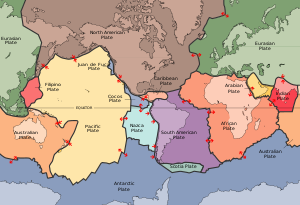Continuing on from my previous post, note this excerpt:

.. with the obvious being that there's little holding back the edge of the North American Plate from resettling. And it's this, coupled with the fact that Florida is too close to sea level, that paints a deadly picture especially for places like Florida, There are still other factors to consider: the plate edges are also resettling along the western edge of the North American plate, however the edge here is not divergent, they are in the process of colliding and rubbing against the Pacific Plate, and though this slows the resettling, it's also creating another type of scenario that again does not bode well for Florida. The plate edges here are generating intense friction that warms the Ocean, and with this increase in temperature two other things come into play: water expansion and greater evaporation. Expansion of the sea is a scary thought, however greater evaporation poses another danger that's makes for a perfect storm of events. Greater evaporation results in more salt being left behind at the oceans surface, and because salt is denser than water, it sinks, a sinking that's the mechanism driving our Ocean currents, and this in turn is the mechanism behind tropical storms, hurricanes, etc. And now you know the full story behind why hurricanes have intensified over the last decade.
Note this excerpt from a National Geographic article : Scientists are Watching in Horror as Ice Collapses:

Florida lay precariously close to the outer boundary of our North American Plate, land that during the previous glacial maximum had remained unglaciated, and so as the sheer weight of the glaciers pressed down on the plates interior, Florida and other land masses along the plate edge, had bowled upward.And continuing with that thread... the residual effects of the last glacial period are at play even today, as the North American and Eurasian plates continue to readjust: rebounding where glaciers had once existed, and resettling along the outer boundaries. This means that land masses such as Florida are in the process of resettling into an ever rising sea, note this excerpt from National Geographic's, Scientists are Watching in Horror as Ice Collapses):
The increased melting of Antarctic ice means that by 2100 the waters surrounding the U.S. state of Florida are likely to rise six feet.The scientists quoted above, measure the effects of glacial melt from Antarctic ice alone. Not factored in is the melt from Glaciers in the Northern Hemisphere, AND they haven't taking into consideration Florida's position of being precariously close to the outer perimeter/edge of the North American Plate that happens to be in the process of resettling, AND nor do they factor into the equation that Florida's edge is "divergent" (meaning that it's in the process of pulling away from the adjacent tectonic plate), note this excerpt from an article on Plates and Boundaries:
Examples of divergent boundaries include:
Scientists are issuing warnings from a variety of angles, like the experts in the first article mentioned above-- 100 years for sea levels to rise 6 feet doesn't seem too life threatening. However they fail to mention other factors that together make for a more "immediate" danger for places like Florida. Note this image from another article on Plate Tectonics that show the divergent plates in the North Atlantic, where the edges of the North American Plate that lay adjacent to the African and South American Plates, are pulling apart...
- the Mid-Atlantic Ridge, made up of the boundary between the North American and Eurasian Plates in the North Atlantic, crossing Iceland, and the South American and the African Plates in the South Atlantic

.. with the obvious being that there's little holding back the edge of the North American Plate from resettling. And it's this, coupled with the fact that Florida is too close to sea level, that paints a deadly picture especially for places like Florida, There are still other factors to consider: the plate edges are also resettling along the western edge of the North American plate, however the edge here is not divergent, they are in the process of colliding and rubbing against the Pacific Plate, and though this slows the resettling, it's also creating another type of scenario that again does not bode well for Florida. The plate edges here are generating intense friction that warms the Ocean, and with this increase in temperature two other things come into play: water expansion and greater evaporation. Expansion of the sea is a scary thought, however greater evaporation poses another danger that's makes for a perfect storm of events. Greater evaporation results in more salt being left behind at the oceans surface, and because salt is denser than water, it sinks, a sinking that's the mechanism driving our Ocean currents, and this in turn is the mechanism behind tropical storms, hurricanes, etc. And now you know the full story behind why hurricanes have intensified over the last decade.
Note this excerpt from a National Geographic article : Scientists are Watching in Horror as Ice Collapses:
Tallahassee
Pensacola
Jacksonville
Panama City
Daytona
Beach
Melting Antarctic means
coastal flooding for Florida
Orlando
Tampa
The increased melting of Antarctic ice means that by 2100 the waters surrounding the U.S. state of Florida are likely to rise six feet.
Fort Myers
Land below high-tide line with six-foot sea-level rise
Miami
50 mi
50 km
Key West
NG STAFF
SOURCE: CLIMATE CENTRAL
REDRAWING THE MAP OF ANTARCTICA
Now think about redrawing the map again, taking into consideration all the other factors I mention above and othwea not mentioned, and the area of blue expands ... to encompass perhaps most , if not all of Florida including the Pan Handle.
No comments:
Post a Comment